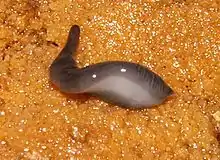Microplana terrestris
Microplana terrestris is a species of free-living, terrestrial flatworm in the order Tricladida. It was first described in 1773 by the Danish naturalist Otto Friedrich Müller as Fasciola terrestris, but has since been reassigned to the genus Microplana.[1]
| Microplana terrestris | |
|---|---|
 | |
| Scientific classification | |
| Domain: | Eukaryota |
| Kingdom: | Animalia |
| Phylum: | Platyhelminthes |
| Order: | Tricladida |
| Family: | Geoplanidae |
| Genus: | Microplana |
| Species: | M. terrestris |
| Binomial name | |
| Microplana terrestris | |
| Synonyms[1] | |
|
List
| |
Description
Microplana terrestris, like all flatworms, is an unsegmented, soft-bodied bilaterian without a body cavity, and with no specialized circulatory or respiratory organs.[2] Like other members of Geoplanidae, it is dorso-ventrally flattened and creeps along with the whole of its ventral surface in contact with the substrate. It is between 1 and 2 cm (0.4 and 0.8 in) in length and between 1 and 2 mm (0.04 and 0.08 in) wide. The anterior end is blunt and the colour is usually black or dark grey.[3]
Distribution
Microplana terrestris is native to Western Europe. Its range extends from Sweden in the north to the United Kingdom and Ireland and France, to Greece in the east. It requires a moist habitat.[4] It has also been introduced into North America.[5]
Ecology and behavior
Cilia provide the propulsive force when this flatworm moves. It can also produce stationary muscular waves along its body which can speed up its progression. It produces mucus as it moves, and when using stationary waves, leaves intermittent "footprints" of slime.[4] It can use its mucus trail as a "suspension bridge" to pass from one leaf to another.[2]
This flatworm is a generalist carnivore, feeding mostly on earthworms, slugs, snails and small arthropods.[5] It rarely attacks live, uninjured specimens, preferring to feed on dead or injured prey.[6]
Sexual reproduction occurs but it is able and frequently does reproduce without mating, producing cocoons containing several hatchlings. The first cocoon is produced 195 (±75) days after hatching and a further cocoon is produced about once a month thereafter. In the laboratory, one individual lived for 39 months. This flatworm is able to regenerate after being cut into two pieces, although it appears to greatly reduce its longevity.[6]
References
- WoRMS (2018). "Microplana terrestris (Müller OF, 1773)". WoRMS. World Register of Marine Species. Retrieved 28 September 2018.
- Ruppert, Edward E.; Fox, Richard, S.; Barnes, Robert D. (2004). Invertebrate Zoology, 7th edition. Cengage Learning. pp. 227–232. ISBN 978-81-315-0104-7.
{{cite book}}: CS1 maint: multiple names: authors list (link) - British Wildlife. British Wildlife Publishing. 2004. p. 192.
- Little, Colin (1983). The Colonisation of Land: Origins and Adaptations of Terrestrial Animals. Cambridge University Press. p. 9. ISBN 978-0-521-25218-8.
- Barker, G.M. (2004). Natural Enemies of Terrestrial Molluscs. CABI. p. 243. ISBN 978-0-85199-061-3.
- McDonald, Jillian C.; Jones, Hugh D. (2014). "Feeding, maintenance and reproduction of Microplana terrestris (Platyhelminthes: Tricladida: Continenticola: Geoplaninae: Microplaninae) under laboratory conditions". Journal of Natural History. 48 (1–2): 1–34. doi:10.1080/00222933.2013.809169.